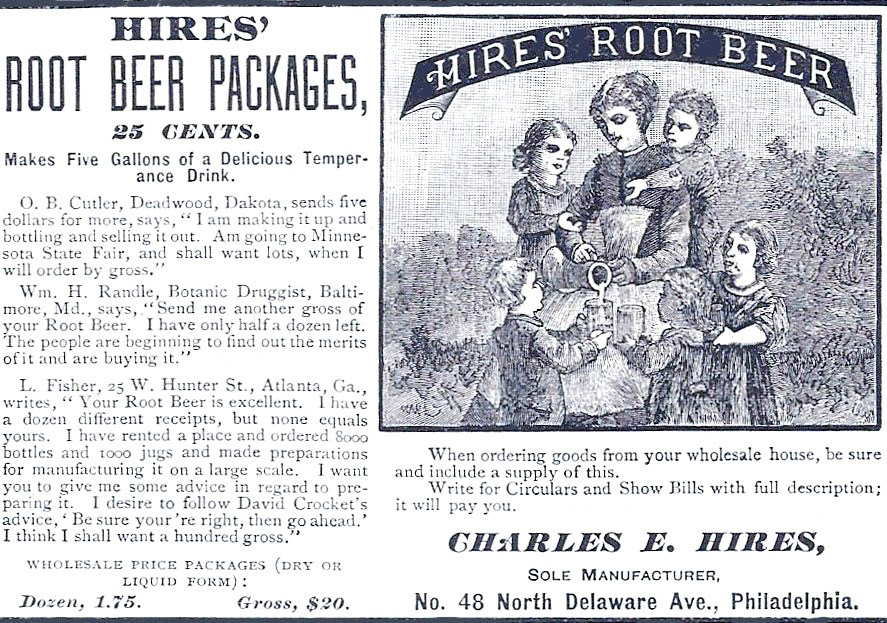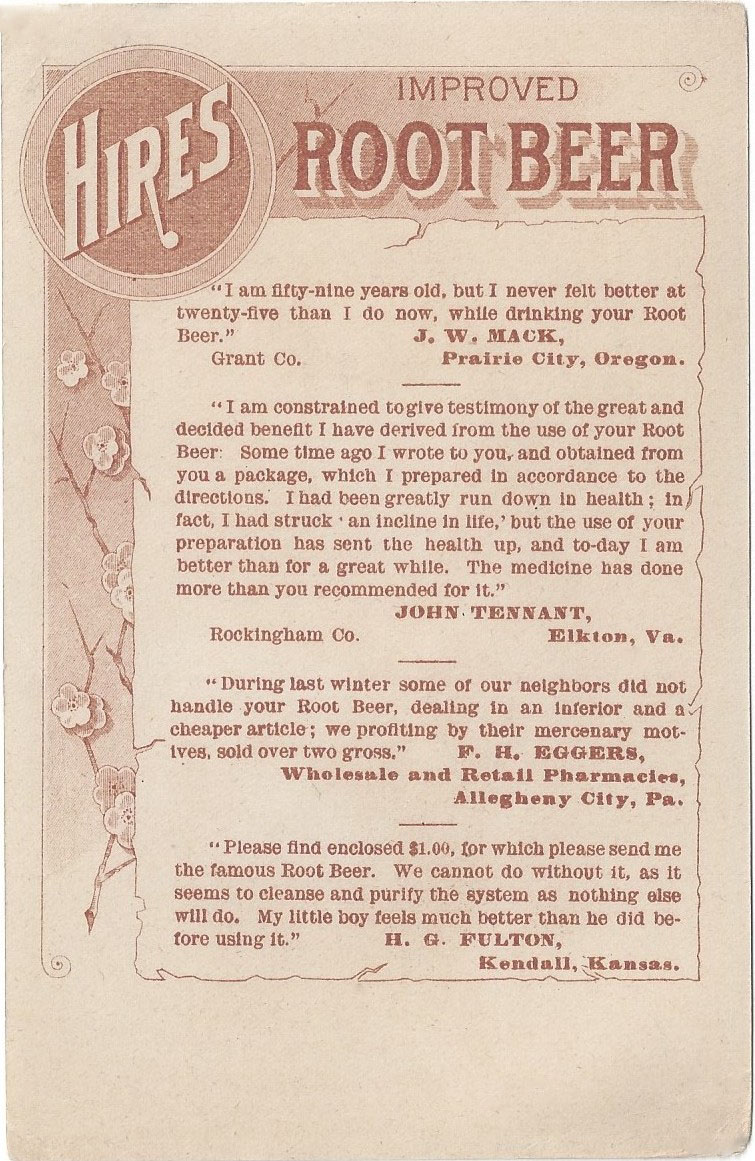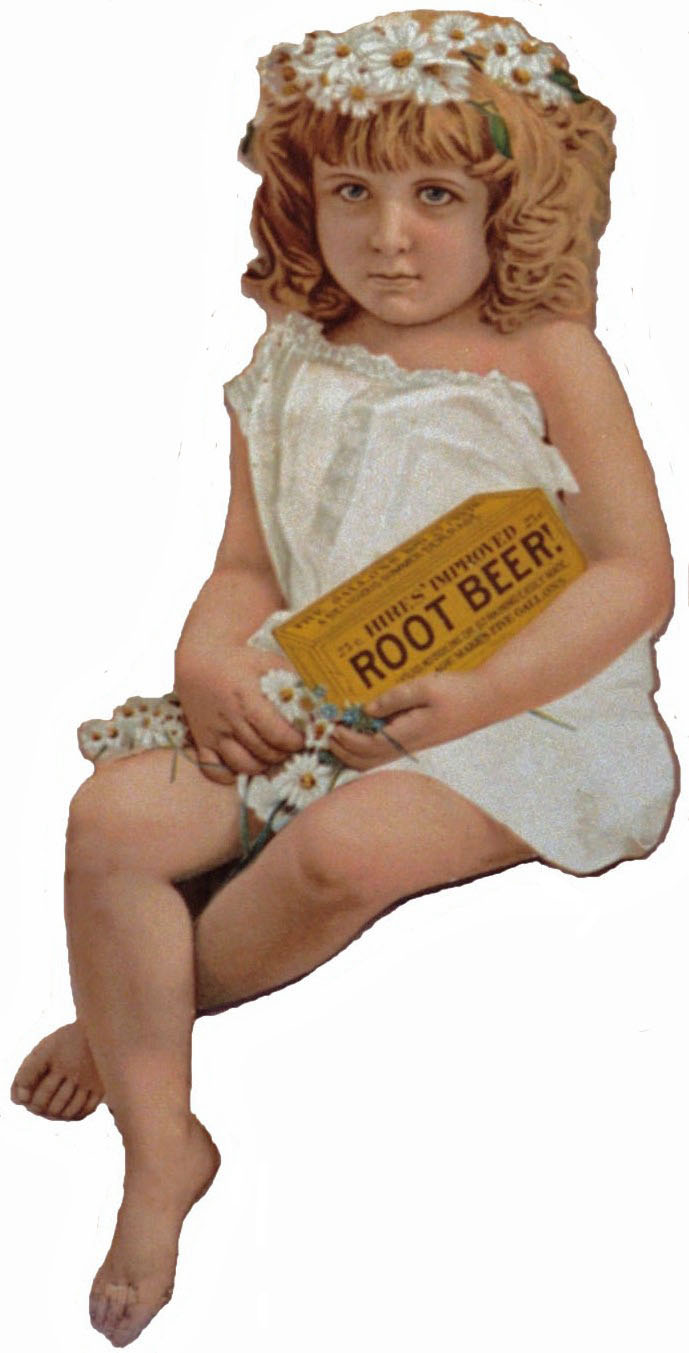1883
IT HAPPENED
IN…1883
Only 2% of the homes in New
York City were connected to water systems.
Minorities, recent
immigrants, Indians, and blacks had few rights or public benefits.
Instead of attending high school, many
children worked in mines and textile mills.
U.S. and Canadian railroads
adopted Standard Time to eliminate scheduling problems.
William Frederick Cody
organized “Buffalo Bill’s Wild West Show.”
The Ladies’ Home
Journal
and
Life
magazines
began publication.
Bottling of White Rock
mineral water began at Waukesha, Wisconsin.
The storekeeper who placed this 1/2" inch newspaper advertisement sold Hires Root Beer by the glass "on Draught," and also Packages for preparation at home.
(Figure
1883-01, Baltimore, Maryland newspaper, June 9, 1883)
During 1883 Charles Hires expanded the size and content of his newsprint advertisements to include testimonials and images. This example targeted druggists and other retailers:
(Figure
1883-01.5,
Philadelphia Cash Grocer, page 9, June 26, 1883)
Note the illustrated advertisement omitted the word “Improved,” perhaps
a typesetting error, or maybe to save space.
The image of a mother pouring glasses of Hires’ Root Beer for
five children clearly illustrates the intentional targeting of families
as customers, a Hires marketing focus for decades.
Wholesale prices for Hires’ Root Beer Packages were $1.75 per
dozen and $20.00 per gross.
Note the packages were offered in both “dry or liquid form,” as Hires
had expanded his manufacturing operation to include producing and
selling both dry (pre-concentrate) and liquid extract.
Hires also returned to the use of trade cards in 1883, purchasing a large supply of the following cards from Gast Art Press of New York City and St. Louis, Missouri:
(Figure 1883-02, “Hires
Improved Root Beer” trade card, front and back)
The young girl pictured on the trade card is seated
on a stoneware pedestal and holding a very large Hires’ Improved Root
Beer package. Hires
distributed these cards to retailers, offering to add their firm’s name
and location at the bottom of the back side.
The text at the bottom front of the card reads “ASK YOUR DRUGGIST
OR STOREKEEPER FOR IT, OR SENT BY MAIL ON RECEIPT OF 25 CENTS.
Copyright 1883. C.
E. HIRES, 119 ARCH ST., PHILA.”
Having already invested in the artwork for trade cards, Hires reused the young girl’s image for this wall sign. Note the slightly different facial expression and much sharper detail on the girl’s face compared with the trade card image.
(Figure 1883-03, die-cut, cardboard sign, 13.0" x 11.0")
Hires also continued to utilize simple magazine
advertisements, such as this example:
(Figure 1883-04,
Harper’s Magazine
Advertiser)
The July, 1883
National Bottlers’ Gazette included these very strong comments about
“QUALITY” penned by William B. Keller, the magazine’s founder,
publisher, and editor from 1882-1929:
It is
a common practice in a number of places to make syrups entirely by
guesswork, and purchases of material are oft-times made simply because
the salesman is a “glib” talker, the merits of the article not being
taken into consideration by the manufacturer…The public is gulled into
believing that, because it has a certain label on it, it is the genuine
stuff…A lack of uniformity in the beverages produced for public
consumption is one of the greatest curses which befalls the trade…It is
all “bosh” to talk equality of goods, when we
know that our “slop”
productions would not stand even the slightest test.
Let us recognize the fact; let us stop bragging about what we
have, and attempt to produce something worth bragging about.
In the manufacture of our goods let us try to excel.
Charles E. Hires was an early advertiser in the
National Bottlers’ Gazette and
he and William B. Keller certainly agreed on the importance of quality.
Indeed, product quality was the cornerstone of the Charles E.
Hires Company’s reputation from day one.
Charles E. Hires Company sales for 1883 were listed
as 28,512 bottles.






